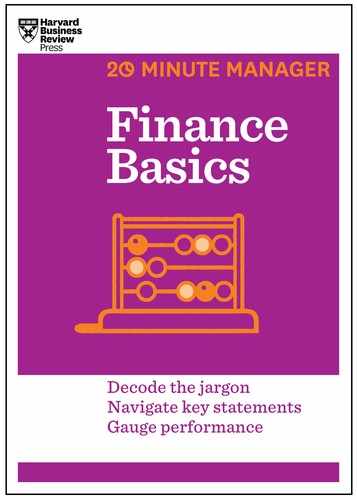Test Yourself
Below you’ll find 10 multiple-choice questions to help you assess your knowledge of finance and budgeting essentials. Answers appear after the test.
1. If you want to recognize the costs connected to a sale during the period when the sale was made, which accounting method would you use?
a. Accrual accounting
b. Cash-based accounting
2. Which of the following would be considered part of cost of goods sold, or COGS?
a. Administrative employee salaries
b. Sales and marketing costs
c. Rents
d. Labor costs for assembling the product
e. Advertising costs
3. In most accounting systems, short-term or current liabilities are those that must be paid in less than:
a. One month
b. Three months
c. One year
4. If the income statement can tell you whether a company is making a profit, what does the cash flow statement tell you?
a. How efficiently a company is using its assets
b. Whether a company is turning profits into cash
c. How well a company is managing its liabilities
5. Many analysts like to look at a ratio that shows how profitable a company’s operating activities are. Which ratio shows this?
a. Acid-test ratio
b. Accounts receivable
c. EBIT margin
6. At ABC Company, unit heads develop budgets for their departments that are linked to company performance objectives. Is this top-down or bottom-up budgeting?
a. Top-down
b. Bottom-up
7. As you begin to prepare your unit’s budget, your manager reminds you to be aware of the “scope” of your budget. What does “scope” mean?
a. The context of the proposed budget: the three to five goals it aims to achieve.
b. The part of the company the budget is supposed to cover and the level of detail it should include.
c. Whether the budget includes revenue and profits as well as the operating costs of your unit.
8. When you’re analyzing ROI, payback period analysis can help you rule out bad investments. What is the main drawback of this method?
a. It ignores the time value of money.
b. It does not tell you how long it will take for the investment to break even.
c. It can be used only to evaluate potential capital investments, not other types of new business opportunities.
9. Your company is considering making an investment that could enable your division to sell more units of new tracking software introduced last year. Your manager has asked you to determine how many units the company would need to sell to recoup this investment. What analytical method might help you come up with an answer?
a. Break-even analysis
b. Net present value analysis
c. Internal rate of return analysis
10. To track your budget, you carry out three steps on a monthly basis. Step two is missing in the list below; what is it?
Step 1. Assess monthly revenue and expense performance.
Step 2._____________________________________
Step 3. Determine whether and how your bottom line will be affected by any variances.
a. Assess your company’s capital expenditures.
b. Revise your forecast for the coming quarter.
c. Determine positive and negative variances compared with budget.
Answers to test questions
1: a. With accrual accounting, costs are matched to the associated sales, regardless of whether cash is actually received or paid in that period. By matching expenses with revenues in the same time period, accrual accounting helps managers understand how profitable a company’s products or services are.
2: d. Assembly labor costs are considered part of COGS. Cost of goods sold includes the materials, labor, and other costs that are directly attributable to manufacturing a product or delivering a service.
3: c. Generally, short-term liabilities have to be paid in a year or less. Long-term liabilities stretch out over a longer period and include items such as longterm bonds and mortgages.
4: b. The cash flow statement tells you how well a company is turning its profits into cash.
5: c. Many analysts use EBIT (earnings before interest and taxes) margin, often known as operating margin, to gauge the profitability of a company’s operations.
6: a. In top-down budgeting, senior management sets specific performance objectives for individual units. For instance, unit managers may be asked to limit expense growth to no more than 5% over the previous year’s expenses. They then develop their budgets within those limits.
7: b. Scope entails two things: the part of the company your budget is supposed to cover and the level of detail it should include.
8: a. Because payback analysis ignores the time value of money, it does not provide as accurate an economic picture as more sophisticated tools, such as net present value and internal rate of return.
9: a. Break-even analysis tells you how much (or how much more) of a product you need to sell in order to pay for a fixed investment—in other words, at what point you will break even financially. You can then use your sales history and knowledge of the market to determine whether the break-even volume is realistic.
10: c. Step two is to compare budgeted figures with actuals and calculate variances. You can then determine to what extent these variances will affect your bottom line.
